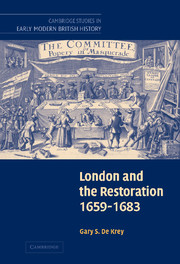Book contents
- Frontmatter
- Contents
- List of figures
- Map
- List of tables
- Preface
- List of abbreviations
- Part I Crisis, 1659–1660
- Part II Settlement and unsettlement, 1660–1679
- Part III Crisis, 1679–1682
- Part IV Crisis and conspiracy, 1682–1683
- Conclusion: London and the end of the Restoration
- Appendices
- Appendix I 1670 London dissenting subscription
- Appendix II London dissenting common councilmen, 1669–1671
- Appendix III Whig party leaders
- Appendix IV Tory party leaders
- Bibliography
- Index
- Titles in the series
Conclusion: London and the end of the Restoration
Published online by Cambridge University Press: 07 May 2010
- Frontmatter
- Contents
- List of figures
- Map
- List of tables
- Preface
- List of abbreviations
- Part I Crisis, 1659–1660
- Part II Settlement and unsettlement, 1660–1679
- Part III Crisis, 1679–1682
- Part IV Crisis and conspiracy, 1682–1683
- Conclusion: London and the end of the Restoration
- Appendices
- Appendix I 1670 London dissenting subscription
- Appendix II London dissenting common councilmen, 1669–1671
- Appendix III Whig party leaders
- Appendix IV Tory party leaders
- Bibliography
- Index
- Titles in the series
Summary
HISTORY: SETTLEMENT AND UNSETTLEMENT
The history of the last eighteen months of Charles II's reign is better considered with that of James II, who shared his brother's new manner of government. After 1683, they together sustained the most comprehensive effort the crown had ever undertaken to manage the localities, and by managing the localities, to manage parliament as well. Charles's abridgement of London's historic autonomy was but the first dramatic step in this initiative. What was intended was a new settlement of church and state, one that would prevent any repetition of the crisis that had just been weathered.
The means to resettlement were a mix of the old and the new. The proscription from local office-holding of those outside the church had been an Anglican loyalist goal since 1661. But the regranting of borough and guild charters that strengthened royal and magisterial authority and that purged companies, corporations, and electorates of many Whigs and dissenters was more drastic than anything attempted in 1662–3. The active persecution of dissenters for the sake of a comprehensive church and of a confessional state also revived older initiatives. What was different was the determination of the episcopal establishment rigorously to apply the coercive policies of the 1660s to the quite different circumstances of the 1680s. Two decades earlier, Reformed Protestants were still reeling from the unexpected disasters of 1660–62 and were reluctant to separate from parish communities they had so recently dominated.
- Type
- Chapter
- Information
- London and the Restoration, 1659–1683 , pp. 387 - 400Publisher: Cambridge University PressPrint publication year: 2005

